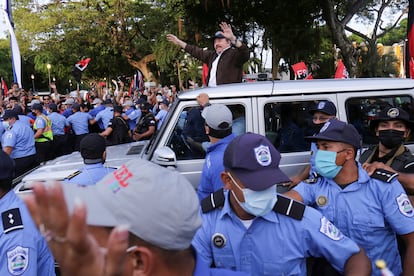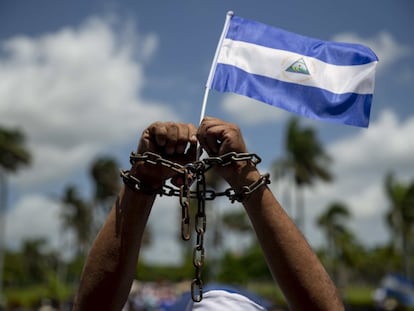Anniversary of the Nicaraguan Revolution marked by discontent with Ortega regime
According to the latest survey by the CID-Gallup firm, 56% of Nicaraguans disapprove of the government, while only 16% of respondents support the Sandinistas


Elvin Enríquez, a young Sandinista supporter, went to a march on Sunday, July 2, to commemorate the anniversary of the withdrawal to Masaya, a tactical move by the Sandinistas that led to the overthrow of the Somoza dictatorship in Nicaragua. “You have to fight and stand firm with Commander Daniel [Ortega] and Rosario [Murillo],” said Enríquez, who was dressed up in red and black clothes. “We have innumerable benefits, urban projects, snacks in schools, it’s not possible to list all the projects,” he said excitedly to state media. The celebrations on Sunday are building up to Sandinista Revolution Day on July 19, which celebrates the triumph of the Nicaraguan revolution in 1979.
Nicaragua has been flooded with propaganda about the 44th anniversary of the revolution and withdrawal to Masaya — a move known as El Repliegue that successfully deceived the armed forces of Anastasio “Tachito” Somoza Debayle. The events are typically used to celebrate the Nicaraguan government, which is governed by Daniel Ortega and his wife Rosario Murillo, who is vice president. Ortega, as one of the Sandinista guerrillas who helped overthrow Somoza, is at the center of the celebrations, as the presidential couple have erased from history all the ex-guerrillas who became critical of their regime — figures such as Mónica Baltodano, Dora María Téllez, who was expelled to the United States, and Hugo Torres, who died in February 2022 while detained in Nicaragua’s notorious El Chipote prison.
But for the past three years, neither Ortega nor Murilla have taken part in the march to celebrate El Repliegue, which used to start from the capital, Managua, and end in the historic indigenous neighborhood of Monimbó.
Up until 2018, when the Nicaragua regime was swept by mass social protests, El Reliegue was a chance for state authorities to parade before crowds. Ortega led the march on foot, but switched to an armored Mercedes-Benz G63 V8 AMG after taking power in 2006, and later traveled by bus. But Ortega and Murilla have not taken part in the march since 2019. Indeed, events to celebrate the Nicaraguan Revolution have become smaller and smaller. Authorities have adapted them to local activities in the different cities of the country. Public employees are required to attend these events and must sign an attendance list or risk dismissal or unwanted scrutiny.
The biggest change concerns the parade to celebrate Sandinista Revolution Day on July 19. Until 2018, it was a big event, with international guests, gigantic stages and lots of pomp and ceremony. But since then it has been reduced to a closed march in Plaza de la Revolución square, where the Sandinista guerrillas entered triumphantly in 1979. It is a much smaller space, and only members of the youth arm of the ruling Sandinista National Liberation Front (FSLN) party and high-level officials are allowed to watch. Fewer and fewer heads of state attend the event. Supporters have to make do with watching Ortega’s speech on television.
“Inability to mobilize their own bases”
Juan Diego Barberena, an opponent of the Ortega government who lives in exile in Costa Rica, tells EL PAÍS that the downsized celebrations show “the regime’s inability to mobilize its own bases.” He adds: “There’s another edge to it: the current sociopolitical crisis, the high cost of living, the general lack of jobs, and the internal contradictions that they [the government] are experiencing. There is exhaustion with his political leadership.”
According to the latest survey by the CID-Gallup firm, 56% of Nicaraguans disapprove of the Ortega-Murillo administration, while only 16% of respondents support the FSLN. The survey found that 23% of the population describe Ortega’s performance as president as “very bad,” while 15% think that it is “regular.” According to the poll, this has led to a drop in support for the official party: 77% of those surveyed stated that they have no preference for any political party.
What’s more, dozens of state workers have resigned or deserted from the Sandinista government to take advantage of the Joe Biden administration’s Family Reunification Parole Processes, which allows them to travel to be with immediate family members in the United States. According to Barberena, not only are Ortega and Murillo not able to pull in the crowds, they are taking advantage of local events to make it look like they have lots of supporters. “The propaganda says they are getting stronger every day, and only they can mobilize [the people] in Nicaragua,” he explains.
Regardless of the criticism, the “co-president” Rosario Murillo effusively announced on June 30 the “beginning of the celebrations for victorious July,” including the event to celebrate El Repliegue. But that march did not even leave Managua. While it covered just three miles, the official media boasted that “400 motorists and thousands of people” had participated.
Sign up for our weekly newsletter to get more English-language news coverage from EL PAÍS USA Edition
Tu suscripción se está usando en otro dispositivo
¿Quieres añadir otro usuario a tu suscripción?
Si continúas leyendo en este dispositivo, no se podrá leer en el otro.
FlechaTu suscripción se está usando en otro dispositivo y solo puedes acceder a EL PAÍS desde un dispositivo a la vez.
Si quieres compartir tu cuenta, cambia tu suscripción a la modalidad Premium, así podrás añadir otro usuario. Cada uno accederá con su propia cuenta de email, lo que os permitirá personalizar vuestra experiencia en EL PAÍS.
¿Tienes una suscripción de empresa? Accede aquí para contratar más cuentas.
En el caso de no saber quién está usando tu cuenta, te recomendamos cambiar tu contraseña aquí.
Si decides continuar compartiendo tu cuenta, este mensaje se mostrará en tu dispositivo y en el de la otra persona que está usando tu cuenta de forma indefinida, afectando a tu experiencia de lectura. Puedes consultar aquí los términos y condiciones de la suscripción digital.
More information
Archived In
Últimas noticias
Most viewed
- Reinhard Genzel, Nobel laureate in physics: ‘One-minute videos will never give you the truth’
- Oona Chaplin: ‘I told James Cameron that I was living in a treehouse and starting a permaculture project with a friend’
- Pablo Escobar’s hippos: A serious environmental problem, 40 years on
- Chevy Chase, the beloved comedian who was a monster off camera: ‘Not everyone hated him, just the people who’ve worked with him’
- Why we lost the habit of sleeping in two segments and how that changed our sense of time










































